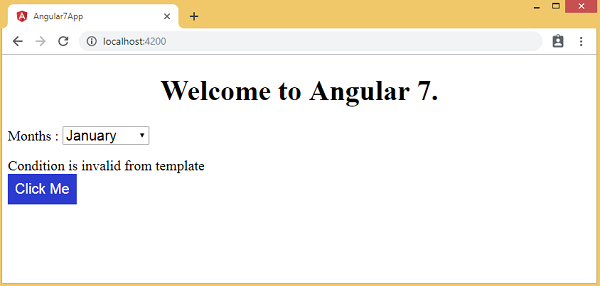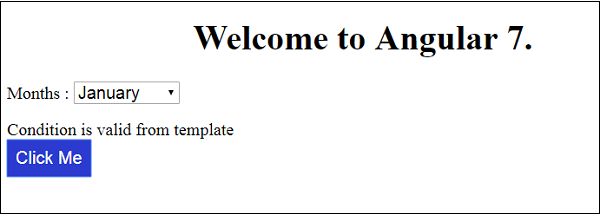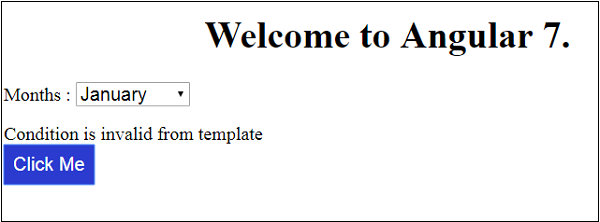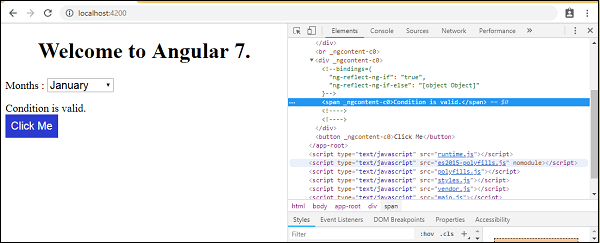Angular7 - 模板
Angular 7 使用 <ng-template> 作为标签,而不是 Angular2 中使用的 <template>。 <ng-template> 自 Angular 4 发布以来一直在使用,早期版本(即 Angular 2)使用 <template> 来实现相同的目的。 从 Angular 4 开始使用 <ng-template> 而不是 <template> 的原因是 <template> 标签和 html <template> 标准标签之间存在名称冲突。 它将完全弃用。 这是 Angular 4 版本中所做的主要更改之一。
现在让我们将模板与 if else 条件一起使用并查看输出。
app.component.html
<!--以下内容只是占位符,可以替换。-->
<div style = "text-align:center">
<h1>Welcome to {{title}}.</h1>
</div>
<div> Months :
<select (change) = "changemonths($event)" name = "month">
<option *ngFor = "let i of months">{{i}}</option>
</select>
</div>
<br/>
<div>
<span *ngIf = "isavailable;then condition1 else condition2">
Condition is valid.
</span>
<ng-template #condition1>Condition is valid from template</ng-template>
<ng-template #condition2>Condition is invalid from template</ng-template>
</div>
<button (click) = "myClickFunction($event)">Click Me</button>
对于 Span 标记,我们添加了带有 else 条件的 if 语句,并将调用模板条件 1 和 else 条件 2。
模板的调用方式如下 −
<ng-template #condition1>Condition is valid from template</ng-template> <ng-template #condition2>Condition is invalid from template</ng-template>
如果条件为 true,则调用 condition1 模板,否则 condition2。
app.component.ts
import { Component } from '@angular/core';
@Component({
selector: 'app-root',
templateUrl: './app.component.html',
styleUrls: ['./app.component.css']
})
export class AppComponent {
title = 'Angular 7';
// declared array of months.
months = ["January", "February", "March", "April", "May", "June", "July",
"August", "September", "October", "November", "December"];
isavailable = false; // variable is set to true
myClickFunction(event) {
//刚刚添加了 console.log,单击按钮将在浏览器中显示事件详细信息。
alert("Button is clicked");
console.log(event);
}
changemonths(event) {
alert("Changed month from the Dropdown");
}
}
浏览器中的输出 −

变量isavailable为假,因此打印条件2模板。 如果单击该按钮,将调用相应的模板。
app.component.ts
import { Component } from '@angular/core';
@Component({
selector: 'app-root',
templateUrl: './app.component.html',
styleUrls: ['./app.component.css']
})
export class AppComponent {
title = 'Angular 7';
// declared array of months.
months = ["January", "Feburary", "March", "April", "May", "June", "July",
"August", "September", "October", "November", "December"];
isavailable = false; //variable is set to true
myClickFunction(event) {
this.isavailable = !this.isavailable;
// variable is toggled onclick of the button
}
changemonths(event) {
alert("Changed month from the Dropdown");
}
}
单击按钮即可切换 isavailable 变量,如下所示 −
myClickFunction(event) {
this.isavailable = !this.isavailable;
}
当您根据 isavailable 变量的值单击按钮时,将显示相应的模板 −


如果你检查浏览器,你会发现你永远不会在 dom 中获得 span 标签。 下面的例子将帮助您理解这一点。

虽然在 app.component.html 中我们添加了 span 标签和条件的 <ng-template>,如下所示 −
<span *ngIf = "isavailable;then condition1 else condition2"> Condition is valid. </span> <ng-template #condition1>Condition is valid from template</ng-template> <ng-template #condition2>Condition is invalid from template</ng-template>
当我们在浏览器中检查时,我们在 dom 结构中看不到 span 标签和 <ng-template>。
下面这行 html 代码将帮助我们获取 dom 中的 span 标签 −
<!--以下内容只是占位符,可以替换。-->
<div style = "text-align:center">
<h1> Welcome to {{title}}. </h1>
</div>
<div> Months :
<select (change) = "changemonths($event)" name = "month">
<option *ngFor = "let i of months">{{i}}</option>
</select>
</div>
<br/>
<div>
<span *ngIf = "isavailable; else condition2">
Condition is valid.
</span>
<ng-template #condition1>Condition is valid from template </ng-template>
<ng-template #condition2>Condition is invalid from template</ng-template>
</div>
<button (click) = "myClickFunction($event)">Click Me</button>
如果我们删除 then 条件,我们会在浏览器中收到"条件有效"消息,并且 span 标签在 dom 中也可用。 例如,在 app.component.ts 中,我们将 isavailable 变量设置为 true。


